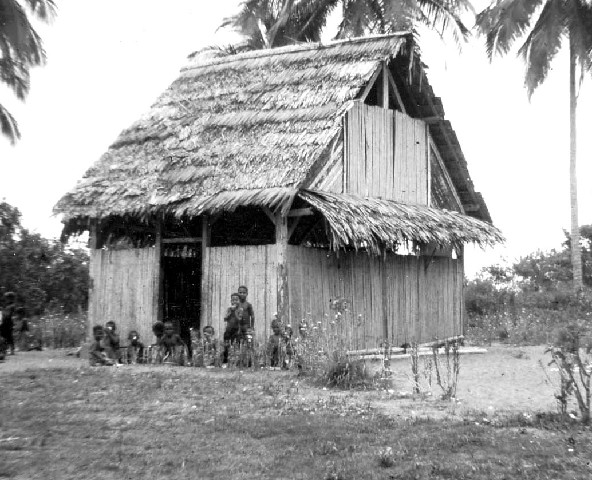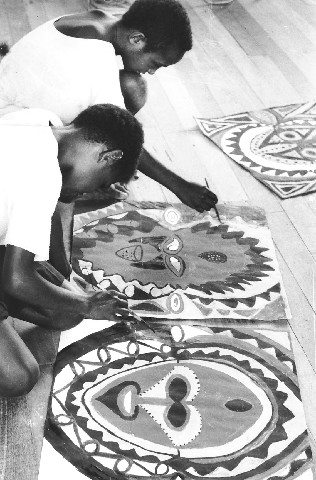Education: Rabaul, Aitape, Maprik, 1963-1972 – Photos from Paul Dennett
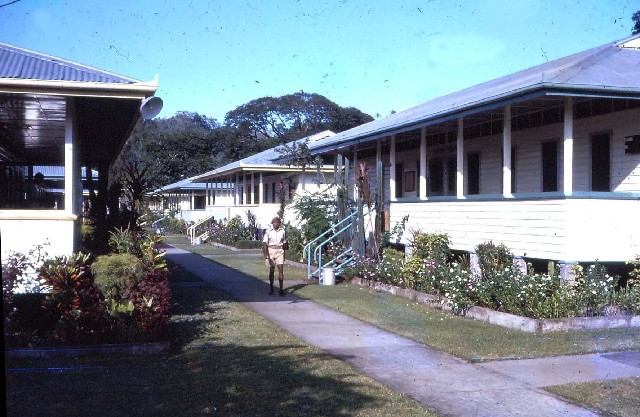
1. Malaguna Teacher Training College Dormitories The College shared a location with Malaguna Technical College, down Malaguna Road, a couple of kilometres from town. E Course students were housed in dormitories which were divided up into reasonably roomy, curtained cubicles for individual occupation. Each cubicle contained a table and chair, a lamp, a fan, a bed, and a wardrobe. The building on the right was the library.
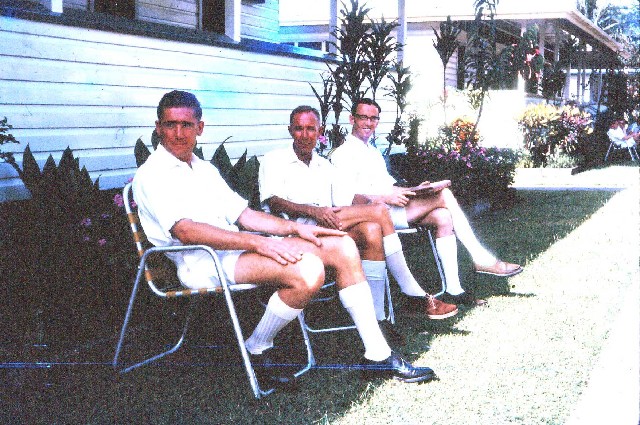
2. 5th E Course Students Trevor Freestone, George New, and David Ament taking their ease outside their dorm. George New, a Pom of middle age, was not included in the list I have still of students who participated in the November 1963 graduation ceremony.
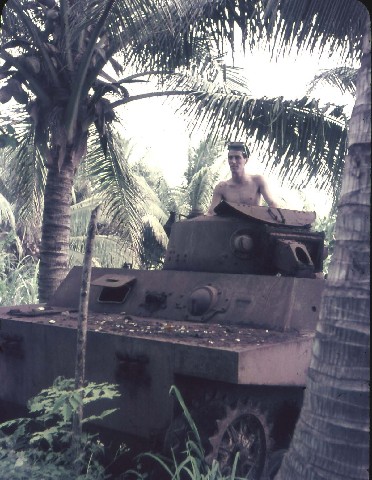
3. Bill Pell in Tank Colonel Ichiguchi (aka Bill Pell) seems to have forgotten his flak jacket and helmet. And what are those things on his head? Underwater goggles!? Perhaps the 'tank' is a kind of submarine.

4. Returning to the College Ken Hitchcock and David Ament on their way back to the College down Tunnel Hill after a swim at Pila Pila. Pila Pila, while not as spectacular for snorkelling as Nonga submarine base, was a bit kinder on the feet and toes. It had lots of sand and made for a more relaxing dip.
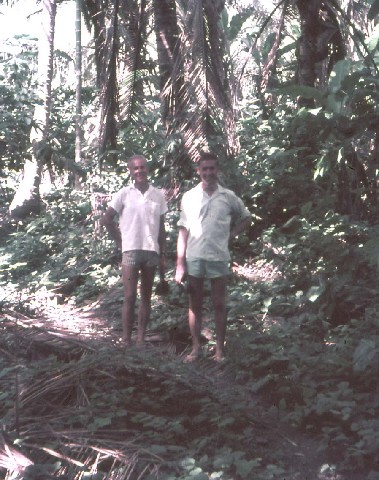
5. On the Way to Pila Pila Jim Cantlay and Trevor Freestone on the way to Pila Pila (just nearby here) for a swim. On one occasion as we were passing through the glade, a mild tremor - guria - set the trees ashiver, and a coconut plopped to earth. The most dramatic guria we experienced while in the College was at the time we were being consulted - (us ?!) - re the establishment of a University in the Territory. The committee chairman was speaking when the classroom we were in bucked & shook. The committee's stenographer uttered a shriek of alarm and Fred Kaad, a member, said, "Well obviously Rabaul's not a good location for expensive buildings!"

6. Inside Matupi Crater Of Rabaul's main smells - copra, fermented cocoa, and brimstone - it was the last-mentioned that Matupi volcano - or 'Tavurvur' as the Tolais call it - supplied the town with. Note the yellow sulphur in abundance. When descending into the crater from the rim, a rope was provided for you to hold onto and you needed to avoid placing your hands over the hot fissures all about, otherwise you could be scalded by the escaping steam. The level 'floor' of the crater, made up of flat, dense, dried-out mud, was nothing more than a giant plug for everything.
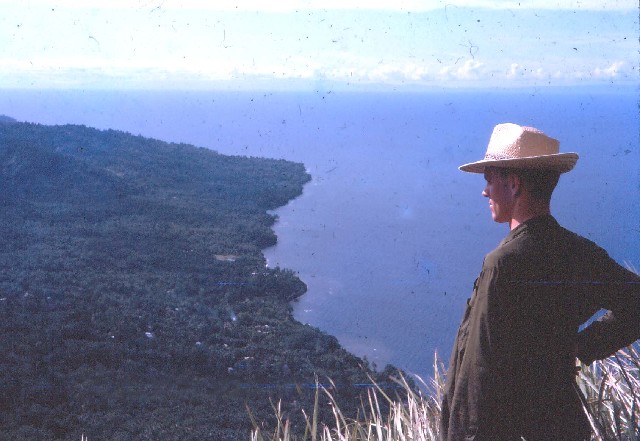
7. The Mother The Mother is a huge hill separated by The Father from Matupi volcano; it is quite a challenge to those who scale prominences "because they're there". All I remember of the excursion is our ascent in the airless heat which was trapped in the tall kunai grass, and the delightful relief of the cool breeze once we'd reached the top.
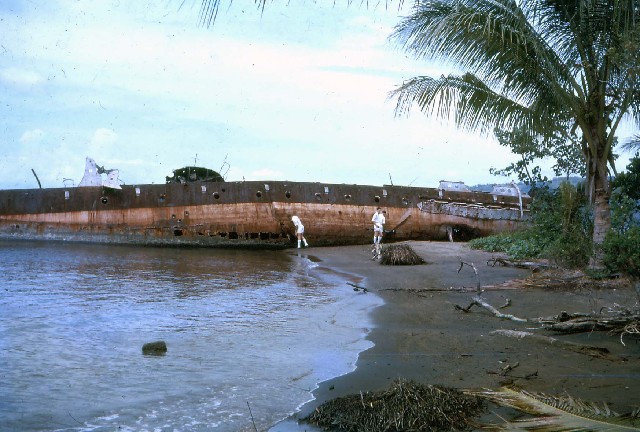
8. WW2 Litter In 1963 there were masses of war junk still littering the Gazelle Peninsula. If you happened to be a war materiel buff then Rabaul was your heaven. Two E Coursers I can discern (from the left) are Trevor Freestone, and next, Bill Pell.
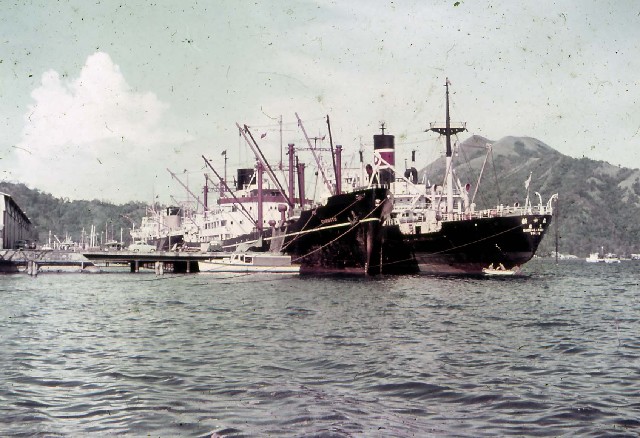
9. Simpson Harbour, Rabaul My tea chest of effects and trunk of books were shipped out of Rabaul from these wharves for Wewak soon after I finished the course in Nov 1963, but what with lengthy stops at Lae, Madang, and Wewak, it was months before I saw any of the stuff at my Aitape posting.
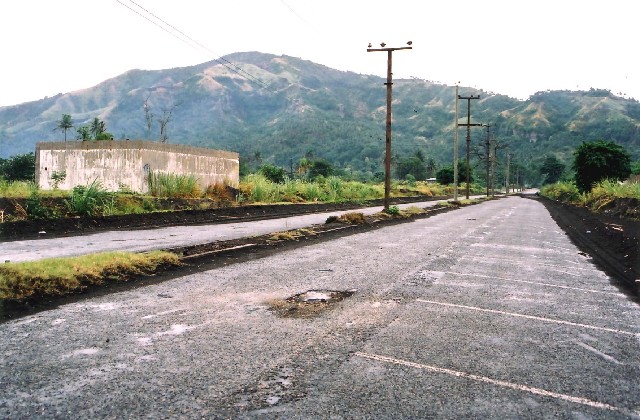
10. Mango Avenue 2004 Post-eruption Mango Avenue in 2004. In 1963 the avenue was lined by big rain trees, and had lots of hibiscus, frangipani, crotons, travellers palms, etc. I remember Colyer Watson's store with its mechanical punkah set on the ceiling - all so tebbly colonial. Just a few metres on the right from where this photo was taken is all that remains of the old Palms cinema - a flight of concrete steps standing by themselves. The Palms cinema was a very popular Saturday night venue, where you could watch the flicks and puff away without breaking any rules on your two-bob-a-packet Gold Leaf fags. Oh those innocent days before lung cancer had been invented! (My wife took this photo - I haven't been back to PNG since I left in early 1986).
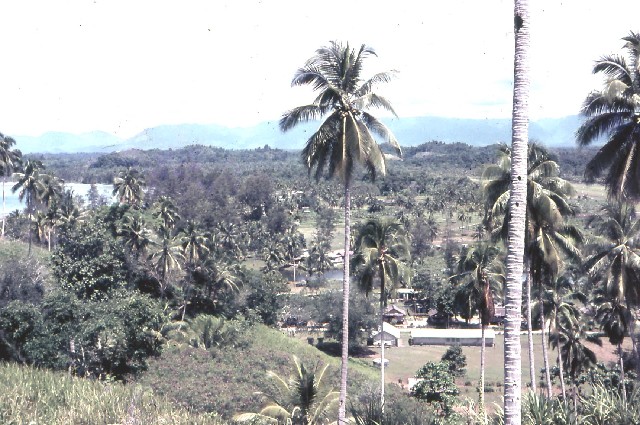
11. View from Verandah of My First Accommodation (a twin donga) at Aitape Aitape Primary T School is in the foreground down the hill. At the end of our course only one Bougainville posting was listed on the College noticeboard, but two students had their eyes on it - Eric Edmondson and I, so we tossed for it. Eric won. (In Bougainville his long stay at his original posting earned him the title of 'King of Konga'). I put my name down for the Sepik along with Bill Collins, Pat Hanrahan, Ian Kneen, & David Ament. On arrival I found that the D.I. (then so called) had put me down for Telefomin and David for Aitape. With the D.I.'s approval we swapped, and at Aitape I met my future wife; we celebrate our 40th anniversary next year.
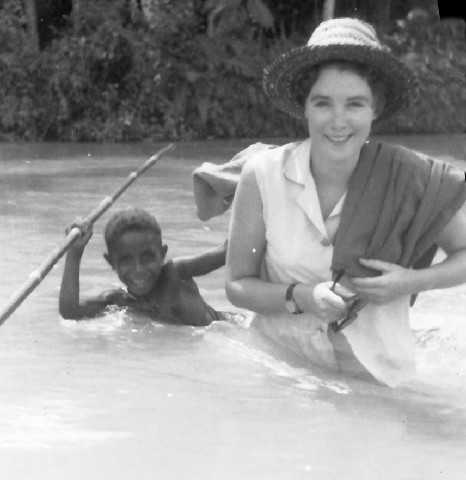
12. Helen Dennett (nee Wiss) Crossing the Yalingi River In 1963 Helen was teaching at Malol Catholic Mission, 25 km up the coast from Aitape (just on the edge of the area affected by the terrible 1998 tsunami). The road was cut by the mostly well-behaved Yalingi River. Here is a much-copied photo (well in Tasmania, anyway) of Helen 'struggling' across it - for dramatic effect she had bent her knees for the photograph.

15. Yalingi Primary T School - 1963 The closest government school to Malol mission school was Yalingi. I think John Allen (2nd E Course) was its founding father. He was certainly the TIC when I was at Aitape 1963/64. Shows what can be achieved with a bit of geometry and a mass of croton cuttings.
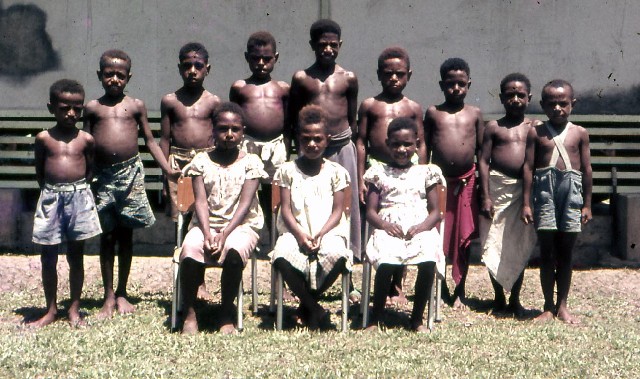
16. Standard 2, Aitape Primary T School, 1963 Bruce Jeans (1st E Course, now retired Professor of Education at Deakin University) was the TIC of Aitape PTS. For the last half-term of 1963 I had a combined Std 2 & Std 4. The boy 4th from the left in the back row I bumped into years later at Waigani, resplendent in safari suit behind the wheel of an official white car. He was a First Assistant Secretary in the Dept of Foreign Affairs. "From little acorns..."
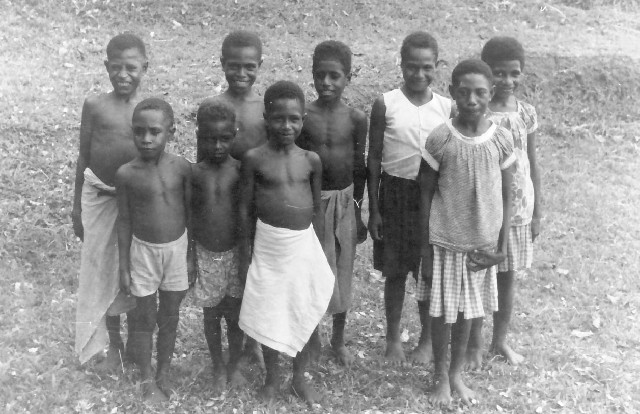
17. A few Members of my Composite Class of Stds 1 & 2 at Aitape, 1964 In my next year at Aitape I had over 50 kids in a combined class of Stds 1 & 2. For a while I thought all my Christmases had come at once - but you can get used to anything. The kids were as keen as mustard and very adaptable to the arrangements I thought up to make the best use of the time we spent together, and we had a lot of fun. I photographed the kids in village groups; here are the Pultaluls if I remember correctly.
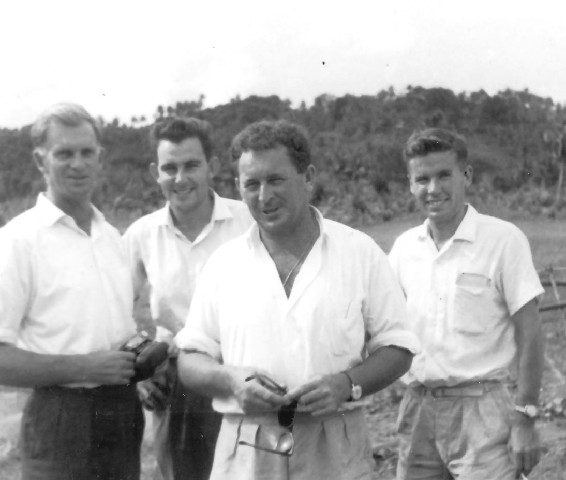
18. Four Mission Pilots, 1963 Aitape was the headquarters of the Franciscan Mission and the seat of a bishop, then Ignatius Doggett, who apart from administering his diocese, managed to combine a smoking habit with playing a mean game of tennis. Here you see four mission pilots who flew in supplies to the bush stations, carried passengers, rescued the seriously ill, etc. From the left are:- Father Urban Reid, a Battle of Britain veteran, Eamon Gaffney, Col Campbell, and Mark Dignam. Mark grew up just round the corner from me in Maroubra, a Sydney suburb. I took his elder sister to my first ball when I was 14. Small world!
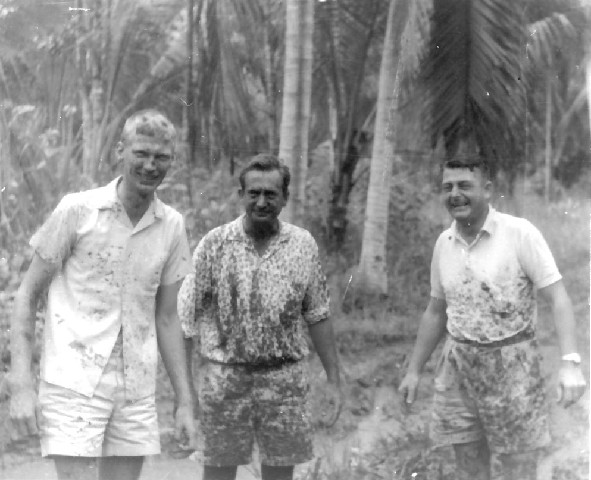
19. The Downside of Weekend Outings in PNG, 1964 The mission personnel in Aitape were very gregarious and hospitable - Friday night was Five Hundred night up at St. Anna. Just as well there was no gambling otherwise the good friars would have reduced their guests to penury. A bad road recently drenched by heavy rain didn't put us off a visit to Pes Mission. We arrived in time for lunch, though looking a little less than spick and span. From left: Bruce Jeans, TIC of Aitape PTS; Kevin Goodwin, a businessman/builder; and Gus Bottrill, ADO.
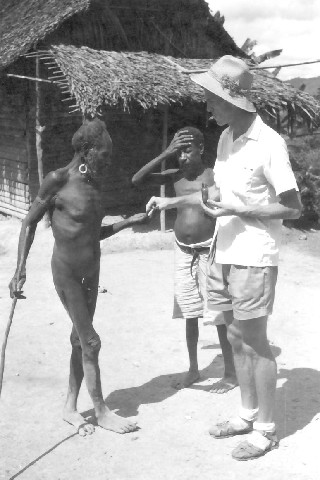
20. Dispensing Aspirin for Hed i Pen, 1964 In the Aitape hinterland at the back of the Torricellis quite a few of the older people didn't bother about clothes still. Here a Wanali Village man cadges a couple of aspirin off me while I was off during a term break walking round the Nuku area with Tony White, a mission teacher from the 5th E Course. (The ADO - or more correctly the Sub-District Clerk - wasn't very happy about me going off without his OK for this excursion during the school vacation as teachers were technically still classed as public servants then).
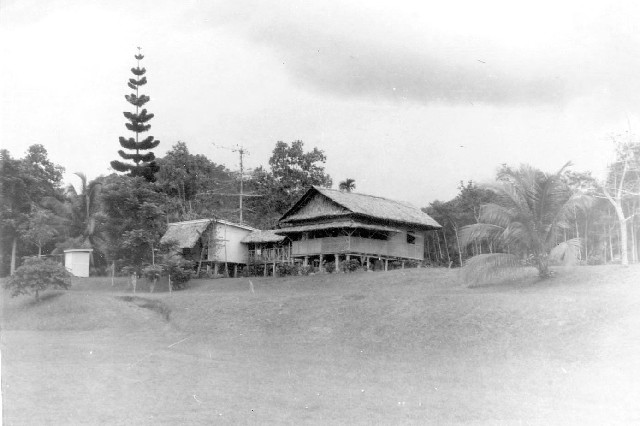
21. House of the Teacher-in-Charge, Balupwine Primary T School, nr Maprik 1965 The original poky, hot, fibro donga had been added to by my predecessor (Ron Thompson?) - additions in the form of an awning for the western sun, a separate kitchen, and a roomy and cool bedroom with verandah, all connected by walkway. During my time at the school there were two attempts by snakes to take up residence in the dunny to the left. A good mosquito net served during the night to keep at bay the large bush rats along with the fierce mozzies.
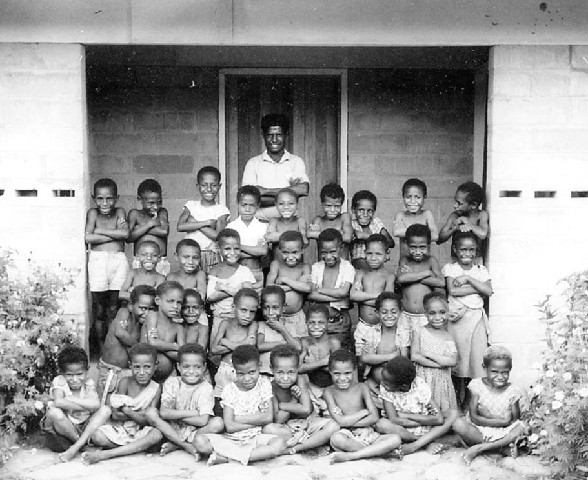
22. Standard 1, Balupwine, 1966 There are only 9 girls in the photograph. When enrolling a new intake I used to aim for the unreachable goal of equal representation of the sexes. Commencement was put off till we got at least a reasonable number of girls. However, attrition began straightway and by the time a class of kids had reached the upper grades, it was only the daughters of enlightened Abelam villagers and those girls who were personally caught up in the excitement of the formal education process who managed to survive. The teacher here, a Manus - only 19 y.o. - used like to play marbles with the adepts in his class and would go into a proper sulk if things went bad for him.

23. Washing for Gold on the Amagu (or Screw River) At one of the first P & C meetings I attended at Balupwine, parents whinged about the modest fees charged for the Association so I suggested that they wash for a bit of gold for the school. The village groups became quite excited at this suggestion and for a while were very competitive, thus boosting P & C funds considerably.
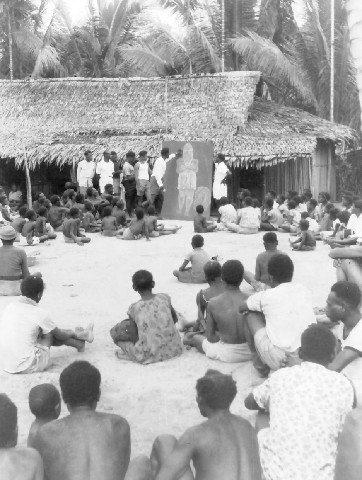
24. The Battle for Souls Passing through Nyeligum village on one occasion I came across an Assemblies of God pastor giving a talk in tok ples on the Book of Revelations. About two thirds of our pupils were AOG adherents; the rest were made up of Catholics with a sprinkling of S.D. Adventists.
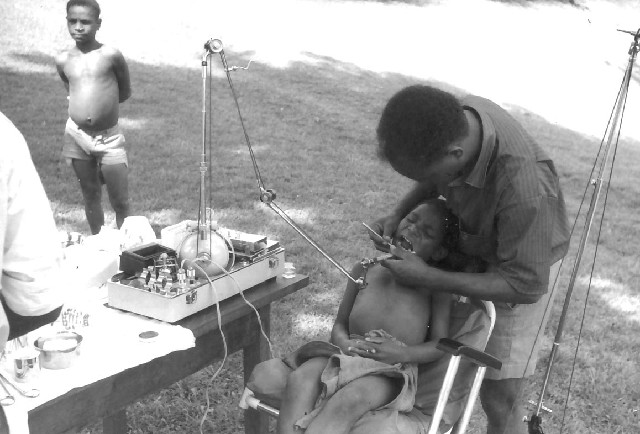
25. A Visit from the Dentist, Balupwine, 1965 The govt. dentist did not stick to a firm timetable (because of weather and other considerations), so we were never sure of just when he'd swoop on the school. When he did, the kids would blanch as much as they were able at the prospect of extractions, fillings, and general torture at his hands.
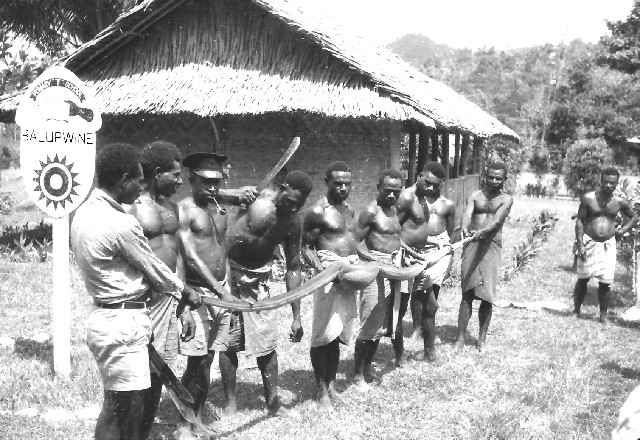
26. Draipela Sinek Parents came along to help clear some ground for a school garden and encountered this python of nearly 12 feet with a digestion problem. The bulge in his middle later proved to be a half-digested wallaby: I declined the invitation to be present when the investigation was carried out.
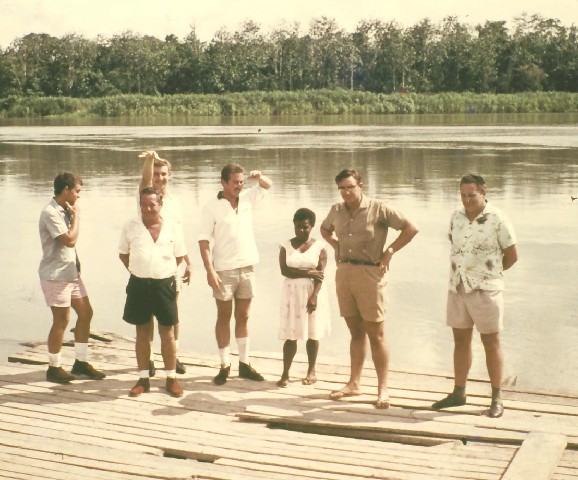
27. Trip to Pagwi, 1966 Weekends could turn out quite bleary affairs if you weren't careful. Often there were excursions out of the centre. On this occasion I went with a group down to the River, to visit the kiap at Pagwi. This 1966 shot shows from the left, on the Pagwi wharf:- David Pennefather (kiap), Robin Brown (kiap) with Murray Phillips (businessman) in front, John Allan (kiap), Rita Phillips (Murray's Maprik wife), Bill van Rikxoort (kiap at Pagwi), and Alfie Schulz (Malaria Control).

28. Dragging a New Garamut back to the Village There was always something going on in Maprik villages. When in this instance the whooping, hullabaloo, and shouts of 'Isa, isa, op!' became too much of a distraction, the whole school went down to the river to investigate. The Kuminibis men were dragging in a recently completed, massive garamut drum. In this photo the river (the Amagu, or Screw) is only ankle deep. Rain in the hills, however, could turn it into a torrent within minutes and everybody knew that if warning calls were passed along in the early afternoon, it was time for the kids living on the other side - more than half of the school's enrolment - to down pencils and cross the river posthaste.
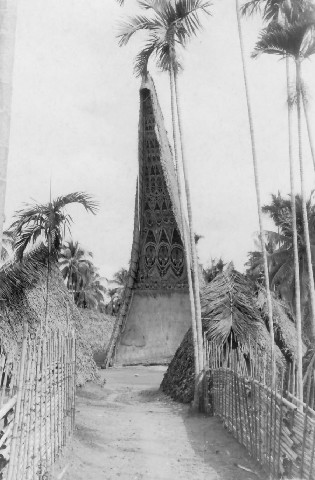
29. A Haus Tambaran in Kuminibis No.1 Village, 1966 These magnificent cult houses only last eight years or so. Each building is associated with a cycle of elaborate ceremonies. At the end of the cycle they are seen to have served their purpose and are then left to rot away.
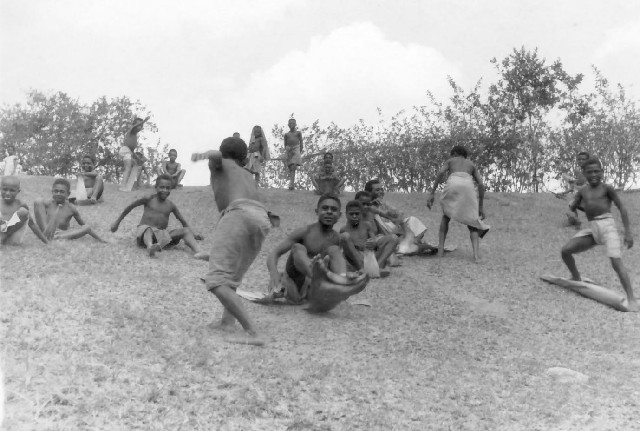
30. Tobogganing in the Tropics!? (Balupwine PTS) In the dry season when the ground and grass had dried off, tobogganing, using the base of a coconut branch, was a popular activity in breaks. In the picture is a future doctor, lawyer, and police inspector.
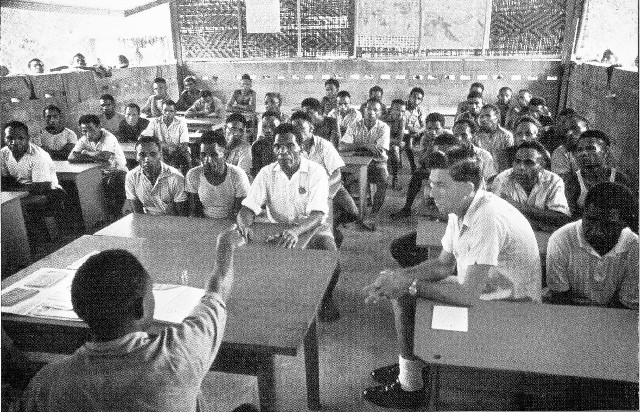
31. Balupwine P & C Meeting (after I had left). Bob Tame (E Courser) and I exchanged schools after I was married in May 1967. I went to Nanu River school with its M-type house and Bob came up to Balupwine with its SOQ. (He grumbled at first but came to fit into the Maprik scene perfectly: he liked company and was an ace golfer and tennis player). Here in this posed shot Bob looks less than his normally enthusiastic self. Minjuan Kokti of Kuminibis, P & C Chairman, (I remember him well), takes to performance with more flair.
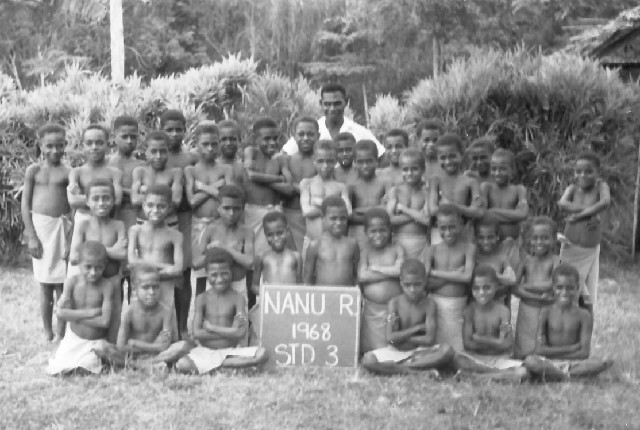
32. Standard 3, Nanu River Primary T School, 1968 The teacher is Yaling Banguk from Madang. The boy directly in front of the teacher with what appears to be light-coloured skin actually has a bad case of grille, or tinea imbricata, a common condition in the Sepik. An effective remedy I saw in the Sepik, rather than taking the nasty and expensive griseofulvin tablets, was the very frequent application of leaves from a common yellow-flowered bush. An S.I.L. worker, who happened to be a pharmacist, and whom I met later in Maprik, identified it in the pharmacological survey of village remedies she managed to put together while attending to her linguistic work.
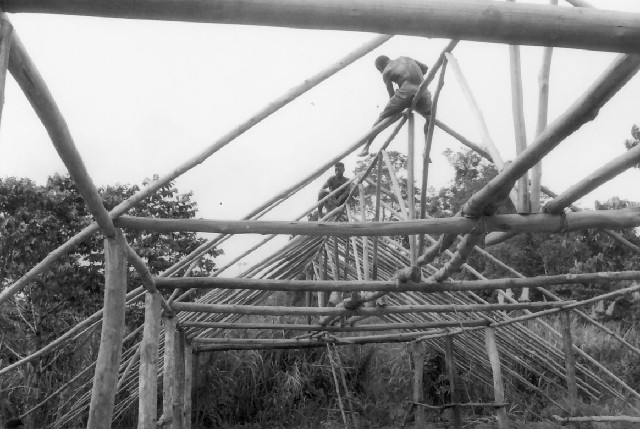
33. A Classroom Goes Up Generally round the Sepik, Monday was Council workday when the villagers were required to work on such council projects as road repair, drainage, etc. If a school needed a classroom we could be flooded with workers who arrived in chattering hordes with the makings of a building - posts, saplings, branches of sago, etc. Under the right conditions (good weather and many pairs of hands), the progress made by the end of the day on a building could be quite astonishing.

34. Nanu River PTS 1968: The Inspector Calls David Franklyn Pitt, District Inspector, on a 1968 visit. (Dave passed away in June 2001 in Queensland). I thought him a good boss - always encouraging and realistic in his expectations
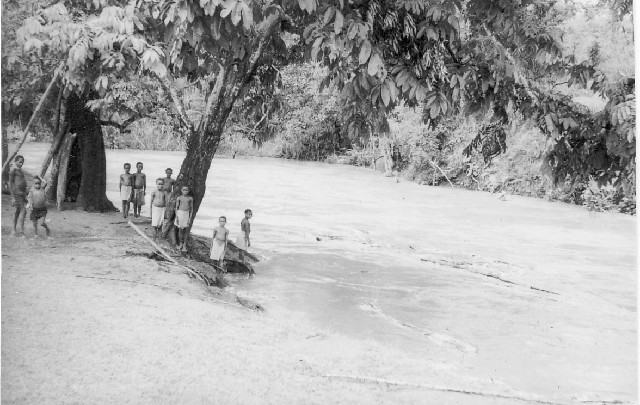
35. Nanu River in Flood, 1968 In the wet season, school activities could be affected by the vagaries of the weather. The prospect of a big flood meant dismissing the kids for the day - the teachers wept bitter tears at the prospect of course. Not long after I left a suspension footbridge was installed.
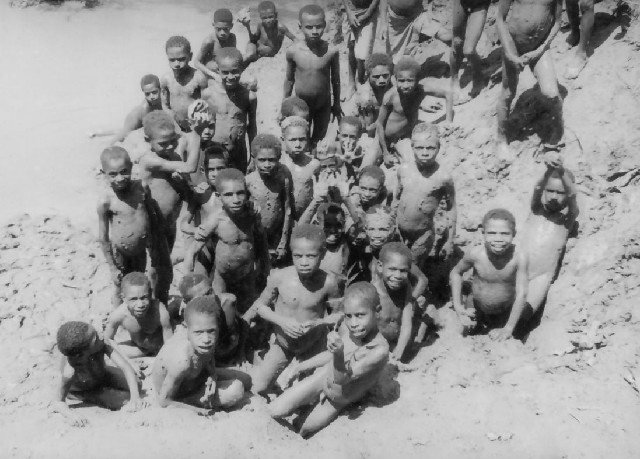
36. Mudsports, Nanu River PTS, 1968 When a flood subsided, soccer balls and softball equipment were put aside and a frolic in the mud became the favoured pastime during class breaks. Even when it was drying out, the children splashed water up to freshen the natural slippery dips formed in the river bank.
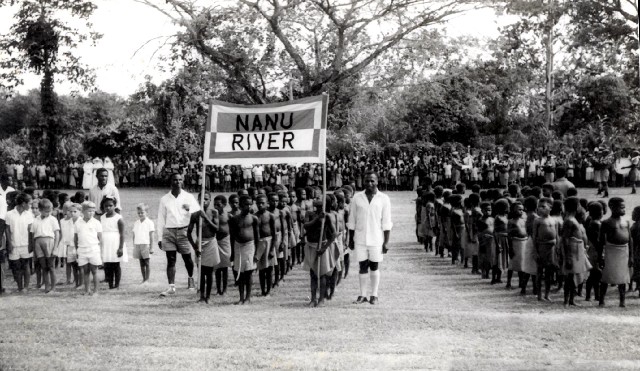
36 (a). Maprik Sub-District Schools Annual Sports Carnival 1968 Participants from Nanu River PTS lining up to march behind their new green and gold school banner.
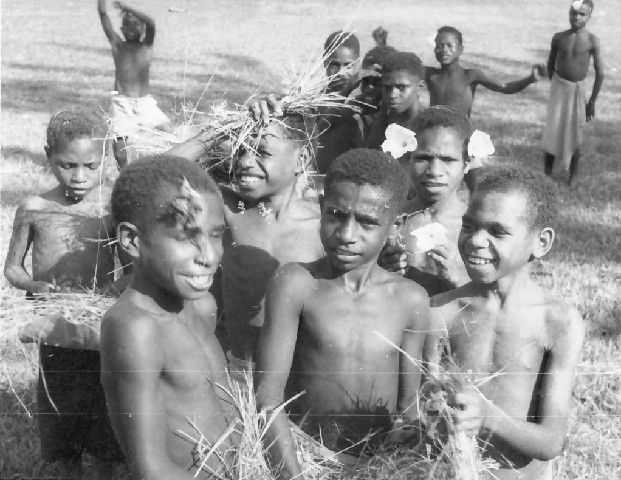
37. Grass Cutting, Nanu River, 1968 Keeping the jungle at bay was one task;another was indulging the White Man's obsession to turn every public space into a potential site for a croquet match. Like most of the country's schoolkids, Nanu River PTS students cut the grass with sharpened pieces of hoop iron - sarifs, in pidgin. After you had cut it, you had to take it away, of course.
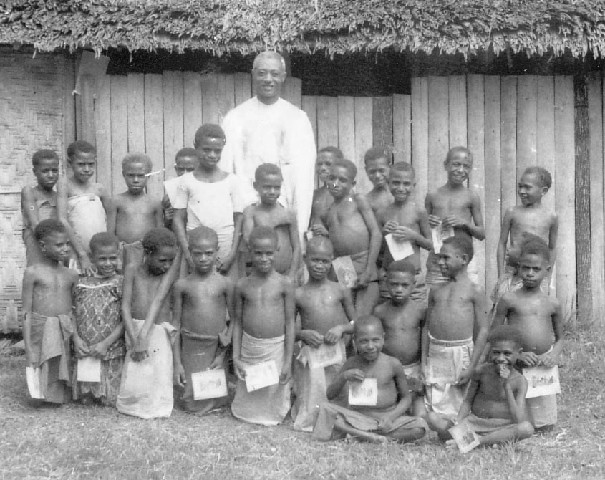
38. First Communion at Kaugia Catholic Mission, 1968 Father Dominic Carmon SVD (now Auxiliary Bishop of New Orleans) prepared a group of Nanu River kids for their First Communion. When they were baptised the year before, the kids asked me for suggestions on names, so I wrote some on the board. Instead of the usual Kontract (Conrad), or Connicondus (boing!), we ended up with an Ambrose, Sylvester, Elizabeth, Barbara, et al. Father Carmon was our near-neighbour. A lively and good-humoured man, he was very good company.
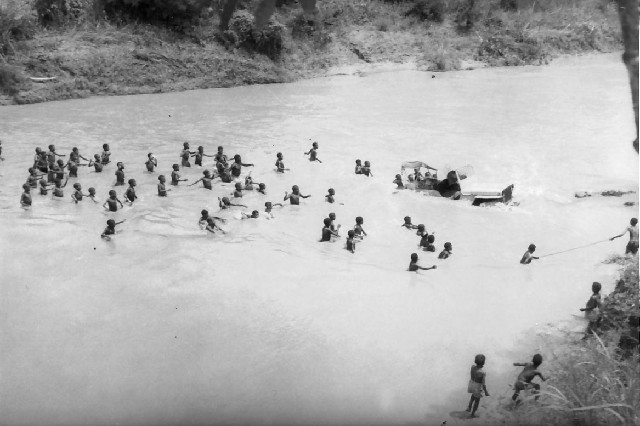
39. Helping the AOG Pastor across the River, 1968 The pupils particularly enjoyed displaying their collective prowess by helping to unbog vehicles from the river. Once when they helped the doubting expat driver of a large geological survey vehicle, producing a great length of cane for the purpose, they were rewarded with a handsome sum of money. This went towards the cost of their Christmas party.
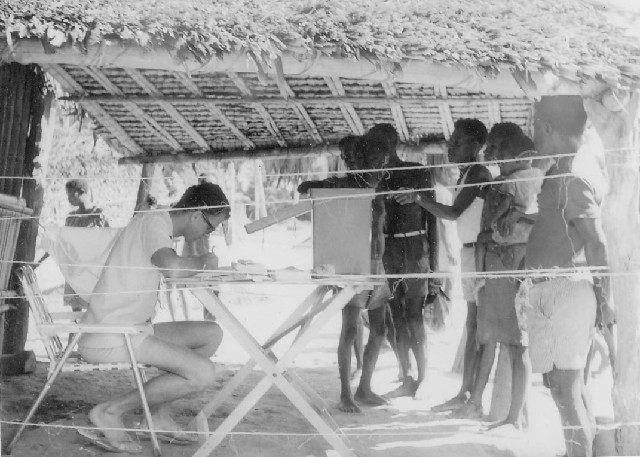
40. House of Assembly Elections, 1968 Many classes of pupils were sent home for the period it took to conduct the ballot for these important elections. Our villages round Nanu River PTS were in the Dreikikir Electorate. Its Returning Officer was Robin Barclay, kiap at Dreikikir P.P. The winning candidate, I remember, was Kokomo Ulia. The preferred method of conducting the poll was to have the voters come forward one by one in whatever order, identify themselves, and collect their ballot paper. I tried this hopeless idea for about five minutes before adopting the suggested old-fashioned bossy kiap approach, bellowing out, 'Ol I lain!' When I had them in village groups, I called out names from the electoral rolls, duly marked the roll and handed out ballot papers as those named stepped forward. The task of attempting to explain the preferential system and the need to mark more than just your favourite candidate on the ballot paper in order to avoid the casting of informal votes, proved most of the time to be an absolute nightmare.

41. Tumbuans 1967 These Wosera tumbuans or bapa are supposed to scare women away from men's ceremonies. Their efficacy seems to have failed in this instance. Actually the occasion here was the opening of the new Wosera Council Chambers, not far from Nanu R. school.
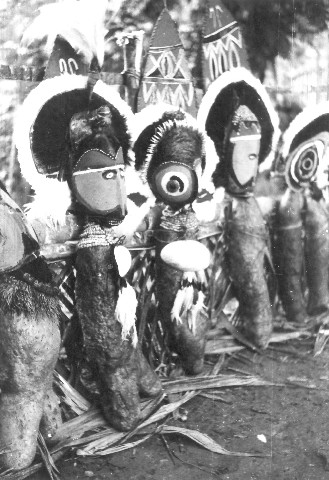
42. Yam Lining, Sarakim Village, 1967 The yam is much more than just a vegetable for the Abelam people. Its cultivation provides a mystical connection with Mother Earth, and its successful production is seen to maintain the physical and spiritual welfare of the clan. The pick of the crop are painted, dressed with woven masks, and displayed proudly in long rows where long discussions are held about which represent the harvest's best. Where yams are concerned, size does matter. The single straight yams are designated male, those with bifurcations, female.
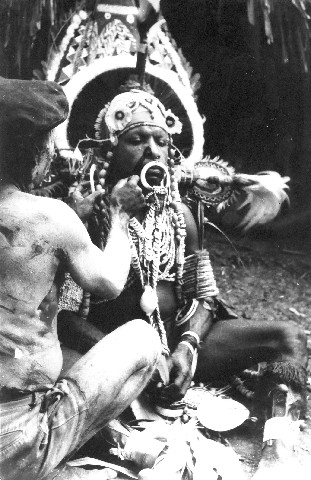
43. A Dancer Prepares - Numbunggai Village in the Wosera The Wosera people occupy the south of the large area inhabited by the Abelam people. There are some variations in their cultural traditions compared to those of the builders of the towering haus tambarans in the foothills of the Prince Alexanders, but the differences are fairly superficial. Nothing resembles a session in the beauty parlour more than such a performer being primped up and made ready.
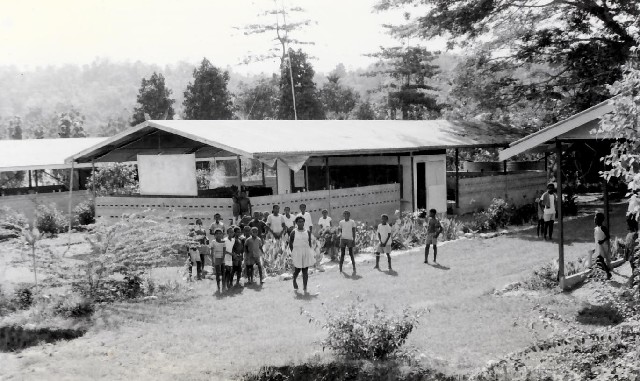
44. Maprik Primary T School, 1970 I moved to Maprik town in 1969 and stayed at the school there for four years. Tino Babao was my predecessor. The school was on the edge of town next to the compound. Maprik was quite the 'Big Smoke' after Nanu River. It had about 80 or so expatriates living in and around the township, and boasted a pub, hospital, post office, stores, a golf course/airstrip, a tennis court - you name it.

45. Some Maprik Pupils, 1970 Some of my wife's class on the back steps of our house up on the hill. They could have been dragooned into a bit of gardening on this occasion.
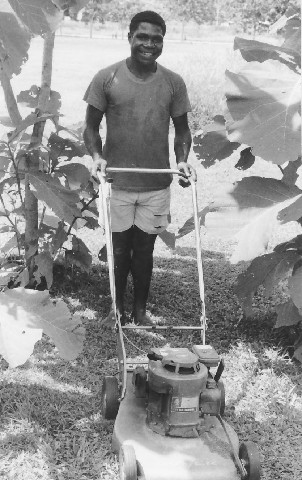
46. Piniwi with the School 'Victa' A couple of the bigger sensible boys were given the job of using the school motor mower. In today's climate in Australia & elsewhere such a practice would go over like a lead balloon with parents and the authorities. He is not wearing shoes or safety goggles either! Olaman!
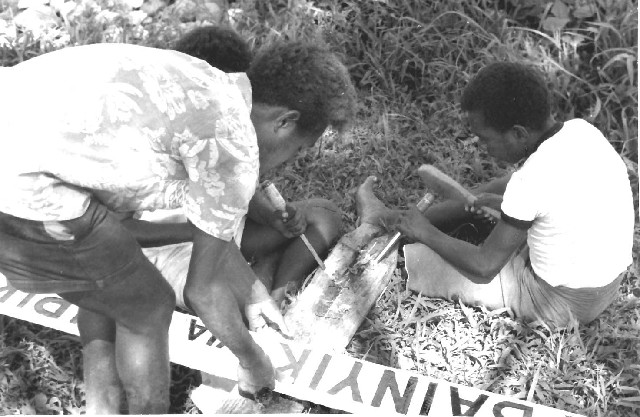
47. Roadsign Making At regular intervals a new education idea would be promulgated from on high (Konedobu) or an old one given special emphasis- cultural activities, Dienes' New Maths, agriculture, community activities or whatever. When the last one became flavour of the month we added to what we already did for the town community (but which was not very obvious - e.g. town clean-ups), by making village and road signs, which many people appreciated.
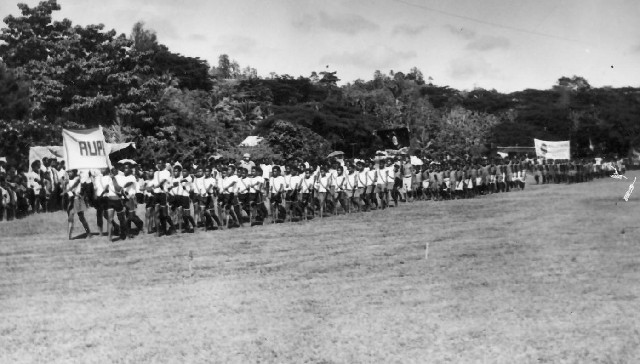
48. Maprik Sub-District Primary Schools Annual Sports Carnival Our annual sports carnival was a major event for the primary schools of the Sub-District and required much planning and preparation. One year it involved 23 primary schools and over 1100 participants. A double set of 100m tracks with half circles at each end for the middle and long-distance races had to be marked out on the golf course, etc. etc. Senior kids and their teachers from a couple of schools were doing this task in 1969 when we dragged out a radio and downed tools for a while to listen as the first man walked on the moon. 'You'll always remember this occasion,' we said. At least I do - for me it's a bit like recalling precisely where you were and what you were doing when you first heard of President Kennedy's death.

49. Annual Sports Carnival (Was this game called Captain Ball?) In 1970 Maprik PTS absorbed the one-teacher Primary A School, just out of town. From then on we were officially known as Maprik Dual Curriculum Primary School, dropping the 'T' from our name - the 'T' standing for 'Territory Syllabus'. The fusion exercise gave rise to lots of heartburn, resembling now and again Alabammy on a bad day.
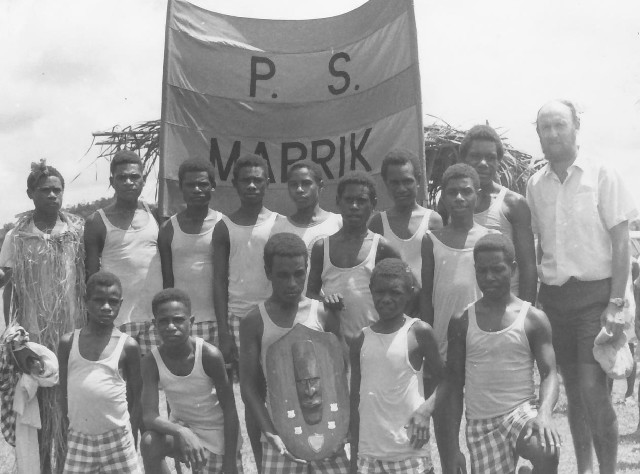
50. Maprik Primary School Senior Soccer Champs, 1972 Bob Kavanagh (E Courser) with the winning soccer team, most of whose members were in his Std 6 class. Both inter-school soccer comp teams, senior & junior, managed to stay at the top of the tree for two years running. The keen coach for the junior team I remember was Elias Wawaongo, a Tolai teacher.

51. Maprik Soccer Champs 1970 Luke Murray, 1970 captain of the seniors and a star sprinter, receives the trophy from the Maprik ADC, John Wiltshire.
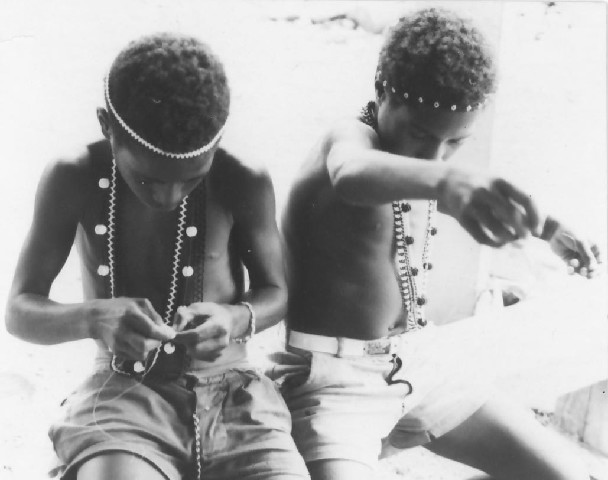
52. Boys Beading 1970 Watedia and Kuiambu at work. My wife was surprised at how the boys in the class seemed to have the edge on the girls in this activity - with more patience application, and creativity.

54. Cariappa Art Shield 1970 Lucas Jakbal was by the judgment of his peers the best painter in his class. He painted this contribution for a group of pictures from the school that were entered into the Cariappa Art Competition. We shared First Prize with Kerowagi High School and were supposed to hold the shield for six months but we never saw it.
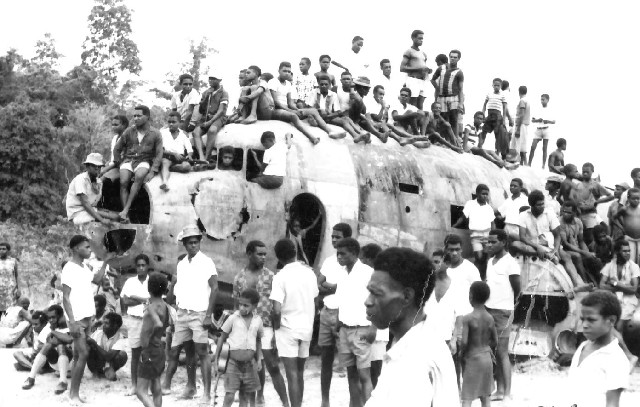
55. 'Back to Wewak' Commemorations - 1970 1970 marked the 25th anniversary of the end of WW2 and ceremonies were held throughout PNG to commemorate the occasion. The Japanese surrender was signed at Cape Wom, just outside Wewak. Maprik High School students cleared the vegetation from the wreck of this DC3 at Hayfield, an airstrip originally set up by David Hay, Administrator-to-be of the Territory of P & NG, and still used today. Schoolkids came to Hayfield in droves to be present at the Maprik commemoration and couldn't resist clambering over the old plane.
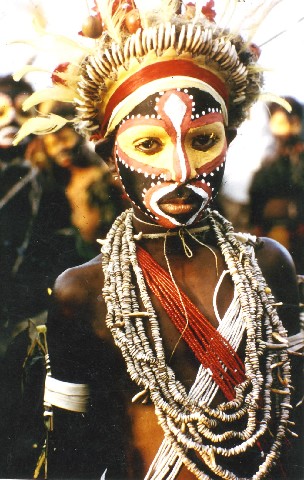
56. Maprik High School Opening In 1971 the Maprik High School students moved from their temporary location at Bainyik, shared with the Primary School and Vocational Centre, to their very own site out in the kunai near Hayfield airstrip. A big singsing was organised in which many schools, including ours, took part. The prize for best-dressed Maprik Primary School student went to this Bongiora boy, prepared by his Dad for the singsing. (This very image appeared throughout the country on postcards for a few years - I took the original photograph).
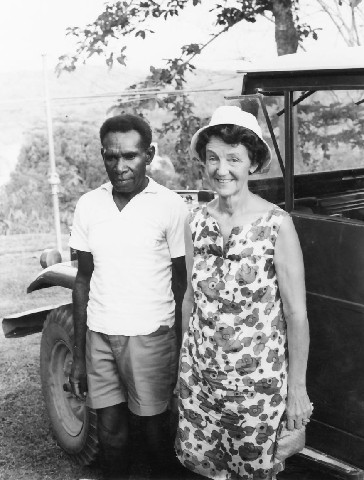
57. Our Education Driver 1970 Patiken, our Education driver, and my mother (up on a visit). Patiken from the Wosera, south of Maprik, drove briefly for General Macarthur in Port Moresby towards the end of the War. He also claimed to have gone as a young copper to London in 1953 to march in the coronation procession. My mother cadged rides with him round the sub-district and they got on well.

58. The Provincial Education Board on Tour Our District Superintendent in 1971, Betuel Peril, decided that the PEB should go on tour and have its meetings in rural locations in order to demystify the Board's activities. Here we're arriving at Kairiru Island for a meeting to be held at St. Xavier's High School. On the left (wading) is Betuel Peril; near him Brother Canute. Half-standing in the boat is Konda Aisoli, associate DEO. Konda was a skilled actor and his distinctive voice was heard in many PNGBC productions. One that any primary teacher would recall is the long-running serial in the Std IV English programme that featured the exploits of Peter, Tano, and the particularly nasty Doriga - remember?
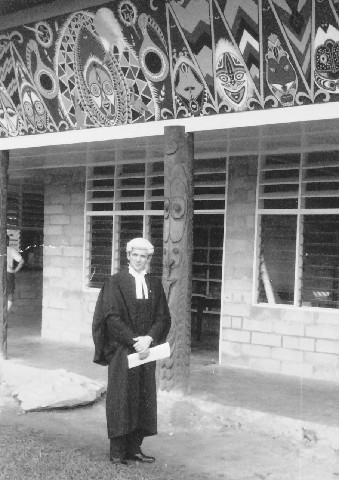
59. Maprik Sub-District Office - 1966 Maprik had a fine and capacious sub-district office which featured carved house posts from the River and large facade panels with Maprik motifs painted by a once-resident kiap, Nigel van Ruth. The barrister, just about to go in to bat for a defendant, is John O'Meally, a friend from the year dot who later took up an appointment on the PNG National Court bench. These days he is President of the NSW Dust Diseases Tribunal.

60. Matthias Yaliwan, Cult Leader, 1971 In the late 60s one Matthias Yaliwan convinced his 60,000 followers that wealth and goods would come to the people if the trigonometric marker on top of Mt. Turu near Yangoru was removed. Game would return to the bush and everybody would have money in plenty. To promote the success of the venture people sat in 'offices' passing round pieces of paper, talking gibberish into tin can 'telephones'; girls shook coins in dishes in money houses to produce increase etc., etc. In mid-1971 the large concrete marker was dug out and passed reverently down the mountain in complete silence and returned to the kiap of Yangoru P.P. The government thought it best to just sit back. As expected, the movement soon fizzled out but Yaliwan was later elected to a seat in parliament, a job beyond most politicians' abilities to make a good fist of in my opinion. Later on I climbed up the mountain with other curious expats to Yaliwan's village, Ambukanja, on Turu's slopes and had an audience with him. Contrary to expectations he was dignified and undemonstrative in his demeanour. Unfortunately I didn't keep a record of our questions and his answers....another lost opportunity!

